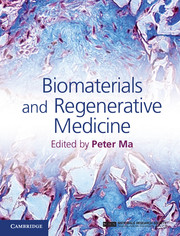Book contents
- Frontmatter
- Contents
- List of contributors
- Preface
- Part I Introduction to stem cells and regenerative medicine
- Part II Porous scaffolds for regenerative medicine
- Part III Hydrogel scaffolds for regenerative medicine
- Part IV Biological factor delivery
- 20 Growth factor delivery on scaffolds
- 21 Gene delivery for periodontal regeneration
- 22 Endogenous stem/progenitor cell recruitment for tissue regeneration
- 23 Affinity-based delivery systems
- 24 DNA delivery for regeneration
- Part V Animal models and clinical applications
- Index
- References
22 - Endogenous stem/progenitor cell recruitment for tissue regeneration
from Part IV - Biological factor delivery
Published online by Cambridge University Press: 05 February 2015
- Frontmatter
- Contents
- List of contributors
- Preface
- Part I Introduction to stem cells and regenerative medicine
- Part II Porous scaffolds for regenerative medicine
- Part III Hydrogel scaffolds for regenerative medicine
- Part IV Biological factor delivery
- 20 Growth factor delivery on scaffolds
- 21 Gene delivery for periodontal regeneration
- 22 Endogenous stem/progenitor cell recruitment for tissue regeneration
- 23 Affinity-based delivery systems
- 24 DNA delivery for regeneration
- Part V Animal models and clinical applications
- Index
- References
Summary
Introduction: stem/progenitor cell recruitment vs. transplantation
The utilization of transplanted stem cells in regenerative medicine has been studied extensively as a potential therapy to repair or replace tissues that are lost due to trauma, congenital deformities, tumor resections, or infectious diseases [1–3]. The current cell transplantation model in regenerative medicine is founded on the principle that the application of transplanted stem cells could repopulate and regenerate damaged or diseased tissues, with restored tissue functions and homeostasis. However, cell transplantation is faced with a multitude of clinical and cell culture complications including the complexity of the multistep surgical procedures, donor-site trauma, immune rejection for allogeneic and xenogeneic cells, cell phenotypic variations due to in-vitro culture techniques, potential tumorigenesis associated with long-term cell expansion, failure of exogenous cell engraftment, and uncertainties and difficulties in the regulatory approval process [4–8]. The difficulties in the clinical application of stem cell transplantation are in strong contrast to the results of multiple experimental studies that demonstrate different levels of efficacy of cell delivery in a number of disease models such as Parkinson’s disease [9, 10], blood cancers and diseases [11, 12], and muscle and spinal disorders/injuries [13, 14].
For a number of regenerative medicine applications, the use of stem cell transplantation might not be competitive with the cost-effectiveness of current clinical treatment modalities in the dental and musculoskeletal fields, including titanium joint replacements, dental implants, and operative dental procedures [15–17]. Alternatively, the concept of endogenous stem/progenitor cell recruitment in regenerative medicine is based on the idea that native stem/progenitor cells that already reside within mature tissue can be stimulated and functionally enhanced to repopulate, repair, and/or regenerate damaged tissues [18]. Relative to stem cell transplantation, the application of endogenous stem cell recruitment in regenerative medicine is still in its infancy. The combination of the use of biological factors, release technology, biomaterials, and bioengineered scaffolds to enhance endogenous stem cell recruitment seems very promising for potential use in translational regenerative medicine. However, further scientific experimentation is warranted, since many scientific questions concerning the mechanistic details remain unresolved and it will be necessary to validate the efficacy of this approach for clinical application.
- Type
- Chapter
- Information
- Biomaterials and Regenerative Medicine , pp. 405 - 418Publisher: Cambridge University PressPrint publication year: 2014



